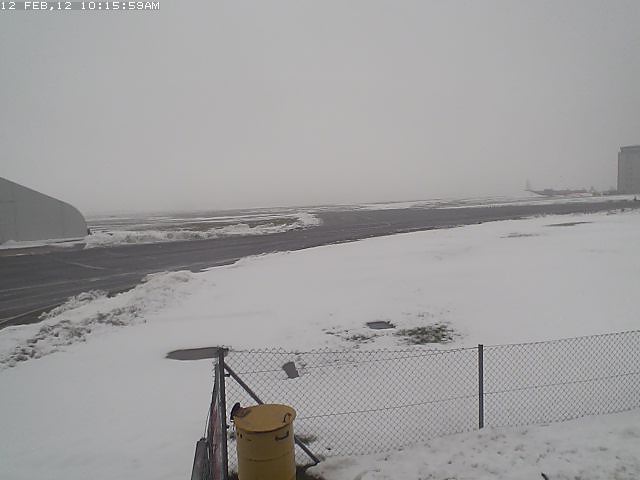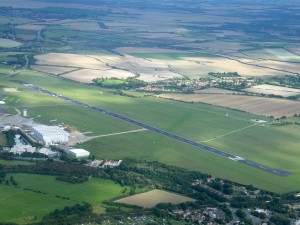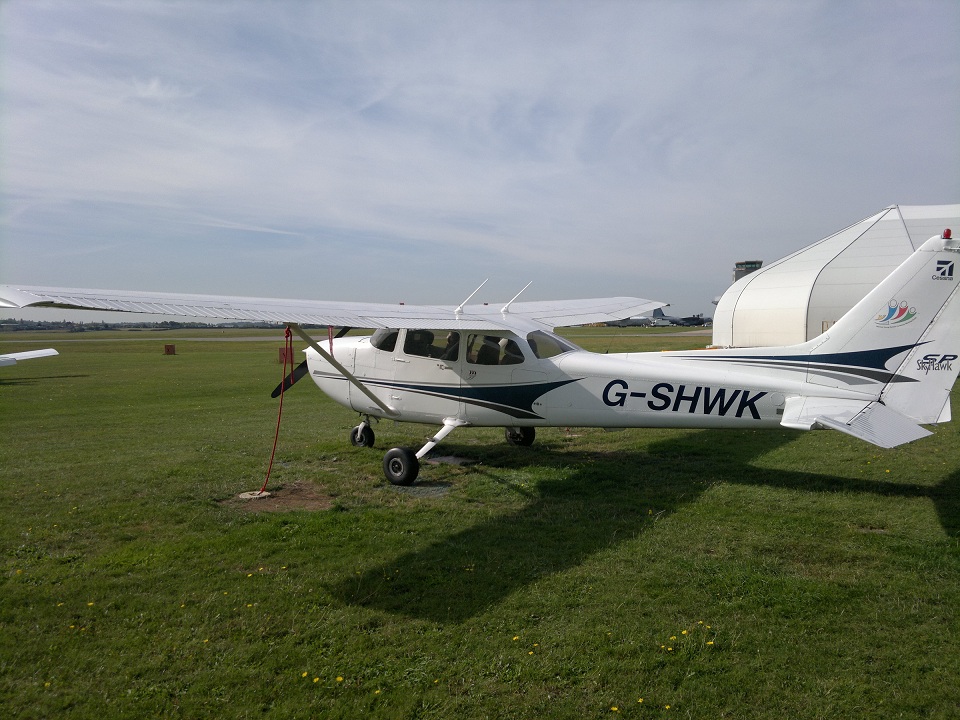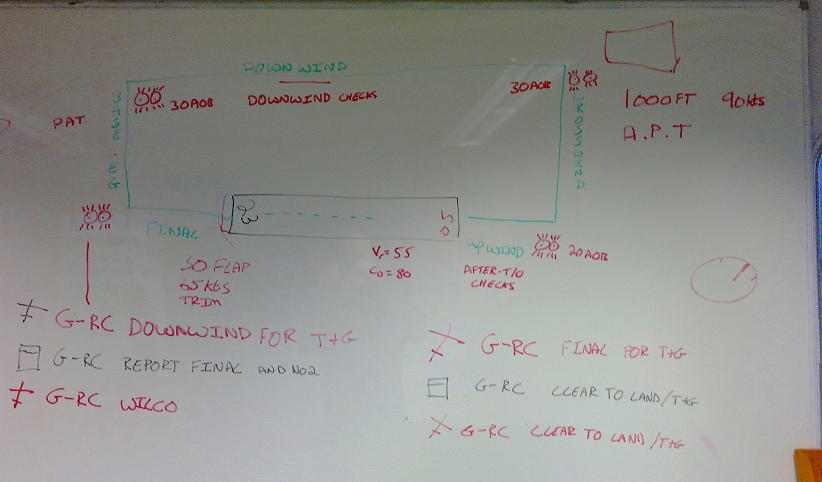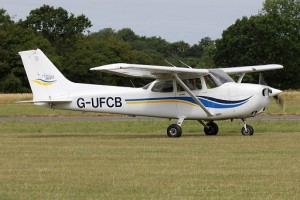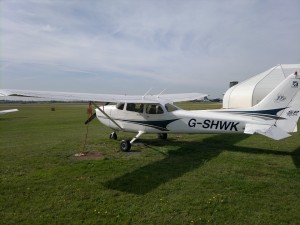
G-SHWK
Upon arrival to the aero club, it had all changed. The club has just taken over responsibility for all general aviation at the airport so it needed to expand, up its admin staff by 100%, fit some new planning desks etc. It’s all looking very professional now, most importantly you no longer need to be ‘buzzed in’ on the front door.
As if the layout changing wasn’t enough, I’d be flying with yet another instructor I’ve never flown with before, but this time an instructor new to the club as well.
Considering the UK weather has been rapidly descending into winter and has generally been rubbish all week, it was now blue skies and very little wind. Good news because to get this phase of the training signed off, I needed 3,000ft.
Briefing & Plane Checkout
Flying G-SHWK, and as the instructor was new and we’d never flown together, the briefing was done over coffee and compared to some, was very thorough in trying to thrash out if I had any theoretical weaknesses before we went flying. Generally it seemed fine, I think I convinced the instructor I knew enough to be comfortable flying with me and we weren’t going to have any awkward “you should know that” moments in the air etc.
This lesson was to sign off the last of my stalling configurations and primarily focused on stalls in the approach & landing configurations (20 degrees flaps and flaps fully down).
As always I’d do the checkout, but as the instructor was new and normally flew a different aeroplane then a Cessna 172SP, she’d be coming out pretty soon after doing the paperwork to look at what I was up to and have a look over the plane for herself.
I noticed the port (left) navigation light was broken, made a note of it and reported it to my instructor – you don’t need it to legally fly in the day, but Whiskey Kilo is used at night at this time of year (I’ve flown it at night). So I wanted to make sure the next night flight had a chance of not getting cancelled because nobody had reported it sooner then their checkout etc.
Spilling Avgas on your hand is no fun in the cold, especially in December (as the fuel evaporates pretty quick and takes the heat from your hand with it, making your hand feel even colder), I could have lived without doing that, but it happens.
Taxi (Avoiding the C-130’s)
New instructors make me screw things up that I’ve had down to a fine art for weeks, I call it “New Instructor Syndrome”. This new instructor was about to prove I suffer from it, again.
Having said I was happy to do the radio, with an instructor who knew me I’d have just gone for it and pressed the transmit button. As we’d never flown together I thought I’d give a little practice run so she felt happy (you’re legally only allowed to use the radio at this stage, becase your instructor is permitting it).
“I’m going to say…………..”
“Errrrm”
“I dunno what I’m going to say.”
Absolute and total mind blackout, my brain had just disengaged. I couldn’t remember it was a Tower I’d be calling, I couldn’t think to say who we were. It was just rubbish basically – in my defence, better to be rubbish off-air, get your act together and then talk sense on-air.
Having got my act together, I radioed our taxi request and because New Instructor Syndrome applies to all things on the ground, the tower came back with a really random request to:
“Taxi between light aircraft, to holding point Bravo, via the grass-way.”
You want me to go where? There’s a grass taxiway? Where’s that then? Now on a normal new instructor day, my instructor would be all knowing of the airport and we’d be off, today I didn’t know and my instructor didn’t know either…….but we figured we’d be able to figure it out and in her words “They’ll tell us if we go to far wrong.”
I don’t think we taxi’d between the correct set of light aircraft, but we went between some and then spotted the grass taxiway – nothing a hard right turn couldn’t fix. We must have been doing ok, because the next ATC call was to another plane to “Follow the Cessna….” Unbeknown to them, me and my instructor were saying “No don’t follow us!!”
The cause for this new and scenic taxi route was because holding point Alpha was having a Galaxy C-130 ‘convension’, there were 2 of them parked up there (they’re far from small planes!).
It was a nice enough taxi, and we’d gone far to long without new instructor syndrome striking.
Take Off
Before take-off you do several things, one of them is a briefing which I’ve just started on (up to this point I’ve assumed me giving the briefing would be fairly pointless because it would go something like “I’ll take off, if it goes wrong, if you could get us down without us dying that’d be great…”). However, this time my instructor basically told me I’d be doing the take off, if it goes wrong on the runway, they expect me to get it stopped and if it goes wrong before 1000ft, they’d expect me to find a field. Ahh such confidence, the reality is I’ve never landed on the runway, so I think they’d be in for an interesting time at the board of enquiries if they let my first landing be an emergency one!
Air Traffic Control continued to cause me grief, on the call declaring us ready for departure, they came back with “Traffic crossing downwind is Cessna, lineup on runway, clear for takeoff.”
The combination of traffic and the lineup threw me completely, I concluded I’d play it safe and called back that I was holding at Bravo……not the right call back at all. Air Traffic came back and repeated their statement of line up on the runway. They’ve never told me to lineup before and they don’t normally give you take-off clearance when they know you’ll go into traffic. Still with a glance at my instructor for this all being fine, I called back we were lining up and we were clear for take off.
Upon lining up on the centre line I could see the silhouette of a Cessna 172SP at 1000ft just crossing the runway takeoff line.
This instructor had told me to do the take off differently to how I’ve normally been instructed to do it (another reason I’m not a fan of constantly changing instructors). For this one, I’d hold the plane on its toe brakes, set 2000RPM and release the brakes and on with full power.
…….done this way, you take off more like a rocket ship then the progressive speed-up you’d get my normal way. Nothing, then power & speed!! How good is this for the brakes? I’ve no idea (can’t really be good for them can it), to be discussed with the next instructor who flys with me. From a personal perspective, this was a more fun way to take off.
The take-off went nice, very smooth, 80 knots climb, give or take a couple of knots this was an on the money climb – no drifting, head up, glancing at the instruments. I couldn’t have done it better, my instructor seemed pretty happy with it and New Instructor Syndrome was left back on the ground.
Contacting Approach
The radio work to date for me has stopped once we’ve left the ground, but since my last lesson I have wanted to do more. Today my instructor seemed to be keen for me have a go at it all, I handed off from the Tower, change frequency on the radio for Approach and for the first time made a call to approach to introduce ourselfs and request a basic service.
Stalling & Lots of Turning
A practice FREDA check, and then we were pretty quickly approaching Grafham water, where we do a lot of flying – it’s mostly fields below so a good place to do stalls (outside of active airspace, not in a built up area etc. – ticks the box for the Location part of HASELL/HELL checks).
From 3,500ft I went into a 360 degree turn, at 30 degrees of bank to the left. By the end of it we were at pretty much the same altitude we started, always a good sign of the turn (esp. 360 turns as they take a while to complete, so if you don’t watch your back-pressure you’ll loose some height typically).
Reduced speed to 1800 Rpm for 80 knots, then down with two stages of flaps and into a routine of pulling back on the controls, pulling back a lot more and more and more some more……before finally at somewhere around the 40 knot mark, a fairly quiet ‘uuurrrrrrr’ from the stall warner. Down went the nose and then into a recovery of pushing the control column forward, unstalling the wings, bit of rudder to correct the yaw that was developing, level the wings and on with the power, upon attaining positive climb up with the flaps before reaching VFE (all in about 3-5 seconds).
Leveling out and bringing the power back to cruise, I’m informed it was a nice recovery but perhaps could be a bit quicker. So as this instructor seems more keen to do full lookouts, it was back into a turn, but this time two 180 degree turns.
Before repeating the exercise above again, seemed good enough so we moved on.
Next was to put all the flap on (30 degrees) and then stall it and remove the flaps in stages. My instructor did one to demonstrate the stages.
Controls were handed back to me, with the plane out of trim (instructors like to do this), I was asked to re-trim it for 70 knots straight and level and then once I was happy it was trimmed to let them know and then we’d do a HELL check.
The “H” in HELL is for Height, and at this point we didn’t have enough of it, as I pointed out we were now at 2900ft. So full power on and into a climb – good example of why you want to check your height as when repeatedly doing manouvers like this you tend to lose height.
Leveling off around 3,500ft, another set of two 180 degree turns then pulling the power back to 1500 RPM, trim for slow flight and then down with the flaps in two stages, re-trimming once down. Then it was back into the task of pulling the nose up to beginning to stall it.
But the difference with this exercise is that you don’t stall it, but recover on the first sign of the stall. The idea being you’re in the configuration you’d be roughly in for the base/final legs of a circuit and need to be able to spot the signs of a stall and recover it before it occurs.
In my case I used the stall warner as the first sign, but if the planes wings had started to buffet first I’d have gone on that or similar first signs.
Upon hearing the stall warner go, it was down with the control column, up with the first stage of flap, on with the power, wait for positive rate of climb and then up with the next stage of flap before finally removing all the flap.
Leveling off, it had felt fairly calm, but a bit clunky in the overall execution. So a quick HELL check (including another full turn for lookout) and it was time to do it all again to iron it all out.
Not so much better in anyway, but just more fluent on the second run.
The instructor seemed happy enough with my stalls, recoveries and general flying (with some good comments on my turns). Time to head for home as we’d been up for what seemed like a long time.
Heading for Home, More Radio Work & Learning the area
As we began making the run back to home, my instructor double checked with me what I thought the city in front of us was – I’m so use to flying with instructors that do this daily and know the area better then the birds. This was a mini eureka moment though, because I found I instinctively turned to look behind me to sanity check where Grafham water was and upon spotting it, that confirmed that if that was behind us, then Cambridge was the city ahead of us. This logical deduction all came out on the intercom as if I knew what I was doing………the small moments like this are the ones that make you feel good.
The instructor said the club encouraged calling in at 5nm from the airport and we were approaching a village 5 miles out, so time to call in: did I want to do it?
There’s only one way to get better at something and that’s practice, so I responded I’d be happy to give it ago.
This was followed by “do you want to request entry to the circuit” and again, there’s not much point saying no – got to get into the habit of doing these calls………all good until they asked if I wanted to accept a right base entry to the circuit? I dunno, do I want to accept that? – I knew what they meant, but whether we were happy with it I left to my instructor to reply.
All in though on this single flight I think I quadrupled the number of radio calls I’d made and blackout at the start aside (which was off-air thankfully), they were all ok.
Descending to circuit height of 1000ft, the wind started to kick in and we were soon getting blown all over the place. My instructor let me do the usual routine of flying it down to around 100ft, reasonably well lined up before controls were handed back.
Upon landing control was handed back to me to taxi off the runway and my instructor said she was quite keen on the accuracy of following the yellow lines – we’d try, but at this airport, you tend to get “chased down” by 737’s, Learjets and Citations…….which makes you develop a habit of “get off the runway, get off immediately.”
Debrief
General summary was that she enjoyed the flight, my take off and climb was very nice (Yay, for once not getting told off for flying on instruments!), my turns were good – not gaining or losing altitude. The stalls were good but her one criticism would be I could perhaps be more forceful putting power back on and recovering faster (a repeat of the previous lessons comments really: Do it faster because for real you’ll be much lower). But all in all a very enjoyable flight.
Stalls are signed off……..next lesson Circuit Flying! (Many hours of flying have been spent looking forward to this phase of the course).

